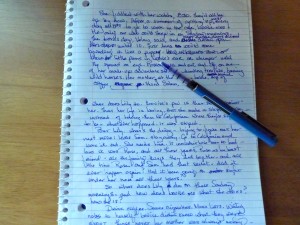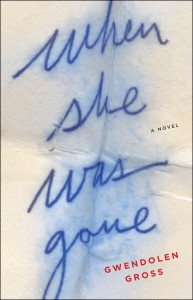For months I’ve been trying to get back into my novel after a year of focusing on the revision of A Writer’s Book of Days, and the subsequent marketing and promotion following its release. The novel, in its third draft, has been receiving what Janet Fitch calls “life-support,” just enough attention to keep it alive in my mind and note a few details or images on the page.
I’ve been told that it takes as long to get back into the novel as you’ve been away from it (Tom Spanbauer) and up to now, getting back into the daily practice of working on the novel has been about as successful as my exercise program. (What do they mean, “Just do it!”?) Something needed to change. And it has.
“Up and Out,” is my new writing practice/daily exercise slogan. I’m lucky. I live within a mile, more or less, of at least seven good cafes, five of them known writing practice haunts, two more to try out.
Here’s how my writing practice went today:
“Up and Out” by 8:15, 1.2 miles to Lestat’s on Park, a place I love for their good coffee, the ambiance (chandeliers, red velvet, and a fake alligator skin sofa bigger than my whole living room) and the owner, John Husler who has welcomed our Thursday Writers writing practice group for five years at the original Lestat’s in Normal Heights.
I’m still inside chapter three of the novel revise, where my character Louise is on a Greyhound bus, headed for Kansas City. She ran away from home the night before, leaving a note on her pillow.
In this draft, I’m re-entering the entire manuscript into my computer from scratch, rather than working with files that already exist. A way of really getting inside the story again, is my thought. When I come to a place that I’ve marked as [NEED MORE HERE] or [OPEN THIS UP] in the draft, I move from computer to notebook to write by hand.
This morning that place showed up when Louise wondered who might find the note on her pillow. One of her little sisters? Her mother? In the first and second draft I avoided going to that deeper place and left Louise staring out the bus window at the cows. Not satisfying or realistic behavior for a character and certainly not very interesting for a reader. (Stare at cows or imagine Mother discovering the note left by a runaway teenager? As a writer, what would you do?)
 In my notebook, I copied the opening of the paragraph, leaving Louise to continue contemplating the cows, and I began writing the details of a Sunday morning at the fishing camp where the family had been all summer. I spent time with Anna, the littlest sister and Roseann, the second sister. Now I needed to go deeper into the character of Lily, the mother.
In my notebook, I copied the opening of the paragraph, leaving Louise to continue contemplating the cows, and I began writing the details of a Sunday morning at the fishing camp where the family had been all summer. I spent time with Anna, the littlest sister and Roseann, the second sister. Now I needed to go deeper into the character of Lily, the mother.
Louise is angry at her mother, so no matter what her mother does, she’s not going to catch a break from Louise. But Lily has her own peculiarities and problems, so what she does on a Sunday morning needs to be true for her as a unique character. (Note: a character without a problem or peculiarity isn’t interesting. “In fiction, only trouble is interesting.” Janet Burroway.)
Fifteen minutes, a cup of coffee and page and a half later, I know what they all do on Sunday morning, and I know how Louise remembers them at their usual Sunday morning activities.
This exercise is what I call “writing outside the story” and to my mind, it’s one of the best uses of writing practice for writers who have works-in-progress. I won’t use all of what I discovered this morning, and I still have to find out what Louise imagines will happen if one of her sisters finds the note. Or Lily, her mother. I can write each scene outside the story, decide which has the most power (who would lay money on the mother?) and then revise the whole thing and put it in the draft of the manuscript.
One more time a fifteen-minute session of free-fall writing practice has given me some rich, raw stuff to work with.
Another 1.2 mile walk home during which I can still smell the exhaust of that Greyhound and see Louise staring out the bus’s smudged window at the brown and white cows, and I’m feeling successful and excited about tomorrow’s “Up and Out” practice session.
 Gwendolen Gross: Thank you! I had hoped, from the very beginning, to write about the hole that someone leaves when they disappear, rather than writing about the disappearance itself, exactly. I also am fascinated by the idea that we all look out of our windows at the street, but we have our lives, our secrets, our slightly different perspective and very different narrative that goes with the view. Character often dictates point of view for me–I decide how close I need to be, and how much fish-eye lens I need to see the character the way I want to see. Writing is all about those lenses, and it’s amazing how you can explore the same subject given different points of view. Often in my workshop, I’ll have students write a paragraph in first person (if I want it to be really complex, I’m make them write about a liar), and then the same paragraph but in third person, or even second, changing lenses.
Gwendolen Gross: Thank you! I had hoped, from the very beginning, to write about the hole that someone leaves when they disappear, rather than writing about the disappearance itself, exactly. I also am fascinated by the idea that we all look out of our windows at the street, but we have our lives, our secrets, our slightly different perspective and very different narrative that goes with the view. Character often dictates point of view for me–I decide how close I need to be, and how much fish-eye lens I need to see the character the way I want to see. Writing is all about those lenses, and it’s amazing how you can explore the same subject given different points of view. Often in my workshop, I’ll have students write a paragraph in first person (if I want it to be really complex, I’m make them write about a liar), and then the same paragraph but in third person, or even second, changing lenses.
